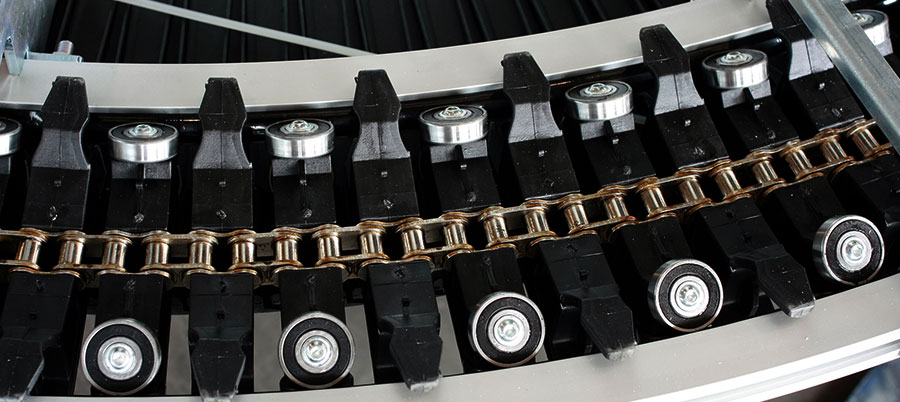
Effective lubrication practices for smooth operation of chains
July 29, 2020
How to clean bearings effectively and safely
October 17, 2020Why recommend synthetic gear oil for industrial gear boxes ?
Modern gear systems are characterized by enhanced power and torque transfer with smaller and lighter gears. The power to weight ratio ( Kg/ Kw) has been considerably reduced over the past decades, which has resulted in increased power density. To accommodate this factor, there have been many mechanical changes made in terms of gear materials, hardening process resulting in wear reduction, improvement in machining methods and tooth geometry. However, the conventional, mineral based lubricating gear oil which was comfortably meeting the demands earlier, becomes severely stressed with increasing power density.
Challenges for the gear oil
The stress on the gear oil is mainly with respect to its anti-scuffing, anti-wear and temperature resistance property. Due to smaller surface area available in the housing to dissipate the internally generated heat, the oxidation resistance of the lubricating oil becomes critical.
The way to reduce internally generated heat is to reduce frictional losses and ensuring a gear cooling arrangement. Frictional losses can be considerably reduced with synthetic base oils which results in reduced operating temperatures. In many cases, external cooling may not be necessary. Synthetic base oils have uniform molecular structure and are more stable than conventional mineral oils. Due to the inherent oxidation resistance of synthetic gear oils, substantial improvement in life time (typically 3 times that of mineral oils) can be achieved. Enhanced life time ensures that frequent disposal of used gear oils is avoided and machine availability is enhanced.
Effective lubrication
Reduced frictional losses, means reduction in input energy required to deliver the required output torque. Hence power saving is achieved with specially formulated synthetic gear oils.
The gear movements are classified as primarily sliding, primarily rolling and combination of sliding and rolling gears. As the sliding percentage increases (for example sliding percentage starts from 10 to 30 % for helical gears extending up to 90 % for worm gears), the shear forces on the gear oil increases. Hence synthetic oils are a product of choice for most of the gear types in industrial gear boxes.
Extend Gearbox life with Berusynth 220 H1
Analysing performance of food grade synthetic gear oil in agitator gear box on slurry line of food processing unit.
Background
Customer: A multinational consumer healthcare company leading the space of health drinks in India with state-of-the-art manufacturing facilities. The maintenance team at one of its primary plants in India currently using Berusynth 220 H1 in its agitator gear boxes had been coerced to benchmark the performance of a comparative synthetic gear oil as an alternative. The trigger for the study was the claim by a competing lubricant brand on further optimisation of gear box temperature with their gear oil, Brand R. Similar to Berusynth 220 H1, the proposed product ‘Brand R’ is also H1 certified and ‘Polyalphaolefin (PAO)’ based.
The particular unit and production lines are dedicated to produce the popular health drink synonymous in Indian households made of ground wheat, malted barley, milk and proprietary nutrients. The agitator gear box is a critical equipment in the slurry line as an interim process that ensures key ingredients mix and blend well before the next end process of drying and filling. A gear box failure would create a serious bottleneck and an undesired maintenance activity for the operations team.

Apart from installation errors, improper alignments, a common cause for gear box failure is insufficient or starved lubrication. Scoring, galling and general fatigue of gear drives are frequently a result of ineffective lubrication leading to metal-to-metal contact and elevated operating temperatures. Elevated operating temperatures in turn expedite the oxidation process, deteriorating further the lubricating and load bearing properties of the gear oil.
As a part of the benchmarking trial process, two similar agitator gear boxes were chosen of parallel lines which were running in continuous process. Both the gear boxes were thoroughly cleaned and filled in with respective oil fills of Berusynth 220 H1 and Brand R.
Gear oil fill quantity : 7.5 l
Motor : 20 Hp
Defined oil change interval : 3 months
The gearbox temperature was monitored for a period of one month on three identical positions of both the gear boxes.
Reading on Machine D2 : Brand R Gear Oil

| Date | Time | Temperature in °C | ||
| Position 1 | Position 2 | Position 3 | ||
| 20.02.2019 | 12.30 PM | 86 | 79 | 82 |
| 20.02.2019 | 14.30 PM | 78 | 75 | 74.5 |
| 20.02.2019 | 18.00 PM | 94.4 | 91 | 89.5 |
| 28.02.2019 | 12.00 PM | 88 | 85 | 80 |
| 28.02.2019 | 17.20 PM | 105 | 103 | 102 |
| 14.03.2019 | 13.00 PM | 97 | 95 | 92 |
| 19.03.2019 | 2.04 PM | 104 | 98 | 97 |
| Average | 93.2 | 89.4 | 88.1 | |
Reading on Machine E2 : Berusynth 220 H1

|
Date |
Time | Temperature in °C | ||
| Position 1 | Position 2 |
Position 3 |
||
|
20.02.2019 |
12.30 PM | 79 | 77 |
76 |
|
20.02.2019 |
14.30 PM | 78 | 74 |
73 |
|
20.02.2019 |
18.00 PM | 84 | 81.5 | 79.3 |
|
28.02.2019 |
12.00 PM | 90 | 84 | 80 |
|
28.02.2019 |
17.20 PM | 82 | 80 | 78 |
| 14.03.2019 | 13.00 PM | 85 | 82 |
78 |
| 19.03.2019 | 2.04 PM | 94 | 92 |
90 |
| Average | 84.6 | 81.5 |
79.2 |
|
|
Avg. temperature difference between Berusynth 220 H1 and Brand R Gear Oil |
8.6 | 7.9 |
9 |
|

Trial conclusion
- It was observed that there was a noticeable temperature difference of about 10% between the gear boxes filled with Berusynth 220 H1 and Brand R gear oil Lower temperature in the gear box with Berusynth 220 H1 can be attributed to effective lubrication resulting in reduction of frictional heat generated
- No leakage of oil was observed
- While Brand R gear oil was also based on Polyalphaolefin (PAO), the formulation, additives and manufacturing process are proprietary for respective brands and play an important role in enhancing the lubrication effectiveness, life and load bearing abilities of Berusynth 220 H1
- After a period of 1 month, Brand R oil on Machine D2 was replaced with Berusynth 220 H1 as the trend with Brand R oil showed incremental temperature rise consistently.
The Maintenance team was satisfied with the benchmarking exercise and continues to use Berusynth 220 H1 and has subsequently recommended the same for other plants.

Berusynth 220 H1 is a high-performance synthetic gear oil that provides superior wear resistance to contacting surfaces. The NSF H1 certified food grade oil has high viscosity index and demonstrates consistent oil film thickness at elevated temperatures. Developed with high quality synthetic base oil and the special additive package, Berusynth H1 grade oils have scored a rating of > 14 stages on FZG load test, proving the scuffing wear resistance of the oil.


